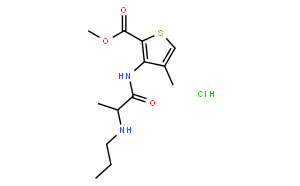| In vivo |
The time to maximum drug concentrations of articaine occurs about 10 to 15 minutes after submucosal injection of articaine 4% 80 mg. The elimination half-time of articaine is about 20 minutes. Articaine is better able to diffuse through soft tissue and bone than other local anaesthetics, the concentration of articaine in the alveolus of a tooth in the upper jaw after extraction is about 100 times higher than that in systemic circulation. [1] Articaine: VAS (Visual Analogue Scale) scores (from 0 to 10 cm) by patients 4 to < 13 years of age are 0.5 for simple procedures and 1.1 for complex procedures, and average investigator scores are 0.4 and 0.6 for simple and complex procedures, respectively. No serious adverse events related to the articaine occurres, the only adverse event considered related to articaine is accidental lip injury in one patient. [2] Articaine results in success rate of 64.5% in electronic pulp testing in healthy adult volunteers injected with 4% articaine. Articaine infiltration produces significantly more episodes of no response to maximum stimulation in first molars than lidocaine. Mandibular buccal infiltration is more effective with 4% articaine with epinephrine compared to 2% lidocaine with epinephrine. [3] Articaine (4%) results in the success rate of 24% for the inferior alveolar nerve block in randomized, double-blind study. [4] Articaine formulation results in successful pulpal anesthesia ranged from 75 to 92 percent and onset of pulpal anesthesia ranged from 4.2 to 4.7 minutes in healthy volunteer. For articaine, 4 percent (two of 56) of the subjects reported swelling and no subjects reported bruising. Ninety-eight percent (59 of 60) of the subjects had lip numbness with the articaine solution. [5]
|

 COA
COA MSDS
MSDS HPLC
HPLC NMR
NMR